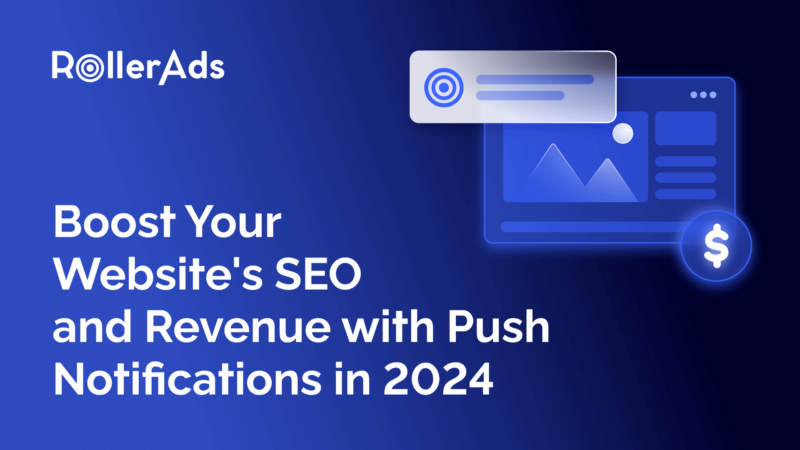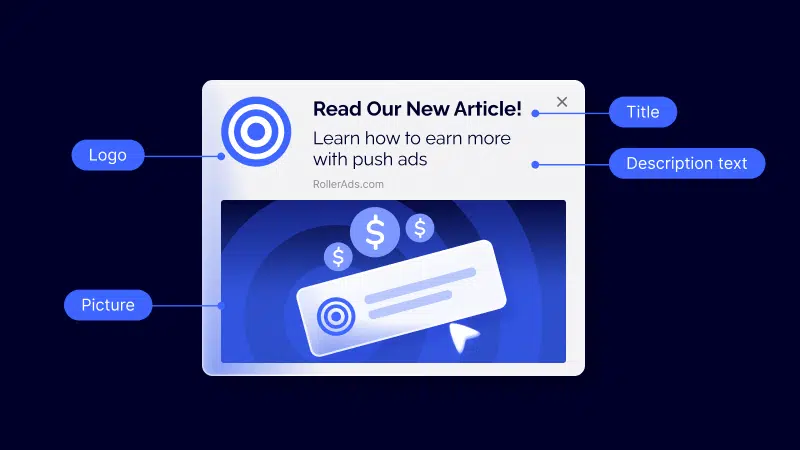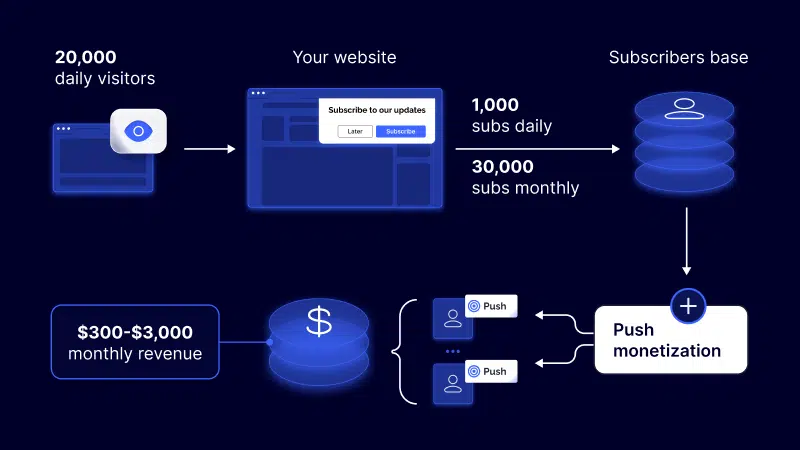Push notifications: The secret weapon for SEO and revenue growth

AI may be getting all the hype and attention right now in SEO, but push notifications remain a proven and effective tool.
At RollerAds, we’ve been working with push notifications since 2019, sending over 9 trillion notifications.
There is a popular belief that SEO and push notifications are at odds. While we understand where this misconception comes from, this myth needs to be debunked.
Push notifications actually help your SEO efforts and can boost your organic traffic.
What push notifications are and why you should use them
Web push notifications are small messages with a picture consisting of a title, description, logo and image. Users who have subscribed to push notifications will receive them directly on the screen of a computer, mobile phone or tablet.
Push notifications appear in the system browser window – not on your website – when the user is online.

For website owners, push notifications are a great way to interact with users, positively impacting the project’s profitability. If you aren’t using push notifications, you’re missing out.
Working with them is easy: choose a provider (like RollerAds), set up a few simple configurations and start collecting a subscriber base, which will become your main asset over time.
Here are the primary benefits of push notifications:
- High subscription rate. Up to 10% of website visitors subscribe to notifications from the sites they visit, according to our network statistics. This means that every 10th user joins your subscriber base, allowing you to communicate with them regularly.
- High click-through rates. Notifications appear directly on the browser screen when the user is online, making them hard to miss. Their CTR often exceeds that of more familiar emails.
- Real-time communication. Instant sending allows you to promptly inform subscribers about the latest news, promotions and special offers, motivating them to visit the site and perform target actions.
- Cost-effectiveness. The cost of a single notification can start from $0.01, which is cheaper than other marketing channels (SMS or email). This allows for broad coverage with minimal expenses.
- Personalization. The subscriber base can be segmented by many parameters, ensuring notifications are as relevant and engaging as possible.
- User retention. Regular and relevant notifications remind users about your site and increase repeat visits.
- Cross-platform reach. Web push notifications can reach users across different devices and platforms (desktop, mobile, tablet), ensuring a broader audience reach.
- Enhanced brand loyalty. Consistent and valuable push notifications help build a stronger relationship between the website and its users, enhancing brand loyalty and fostering long-term engagement.
Push notifications are versatile and can be applied to different types of projects. For example:
- News portals can use push notifications to inform about the latest updates.
- Ecommerce sites can notify users about sales, exclusive discounts and new product launches.
- Streaming services can invite users to watch a live match or inform them about the release of a new episode.
How push notifications affect SEO
Most importantly, push notifications do not directly impact SEO. It all depends on how you use this tool: your approach can either help or harm your website.
But if you follow common sense and monitor how your audience reacts to push notifications, they can yield excellent results.
Page quality remains the same
The most common misconception is that push notifications clutter the page with irrelevant content and links, causing search engines to consider the content less valuable and hurt organic search rankings.
In reality, this is a myth. Web push notifications are sent by the browser within the browser. They are not part of your page experience.
Page load speed stays as fast as ever
The tag that triggers the subscription prompt for push notifications is virtually weightless.
The subscription prompt itself is a built-in browser tool, and its operation is not related to the site’s load speed.
UX/UI is preserved even with push notifications
Many believe that the subscription prompt for push notifications worsens the user experience, and if someone allows notifications, they will be bombarded and immediately leave the site.
In fact, it all depends on how you approach them.
You don’t have to aggressively offer users to subscribe immediately. If you do it organically, explaining the value of your messages, people will be more likely open to receiving them. Choose the timing of your messages so they are always on time, ensuring users don’t feel pressured into subscribing.
Push notifications positively affect traffic
While website traffic is not a confirmed direct ranking signal, we know from the recent Google leak that it appears Chrome data may be used for ranking. So if you’re using push notifications, this could send positive signals to Google, which could positively influence your ranking.
It’s simple: when you publish a new page on your website for your target audience, and inform your subscribers about it, they are more likely to return to your site to check it out. This way, you get more repeat visits – and perhaps a longer time on site and more page views per visit – all of which could make Google view your site more valuable.
By bringing back your target audience, you can expect greater engagement metrics. Google watches user behavior – so anything you can do to signal to Google that your content is popular and worthy of high ranking is powerful.
Push notifications help new content appear in Google Discover
Many websites want to be featured in Google Discover because it drives significant traffic to their pages. One effective strategy to achieve this is by using push notifications.
Numerous quality visits to a newly published page also signal to Google that this content is popular, increasing the likelihood of appearing in Google Discover.
Additional income with the same base via monetization
We’ve detailed what push notifications are and how they can positively impact your website. Now, let’s explore another significant aspect. If you thought there was no money in push ads, you were mistaken. In 2023, global spending on push notifications reached $2.67 billion. This figure is expected to rise to $3.5 billion by 2029, according to Statista.
At RollerAds, we specialize in push notification monetization, so we’ll briefly explain how you can benefit from this format using the same subscriber base. In short, push monetization involves allowing ads to be shown to your website or landing page audience.
The process is straightforward:
- Installing code. You install a piece of code on your website.
- Subscription prompt. Visitors to your site receive a prompt to subscribe to notifications.
- Building a subscriber base. Those who subscribe are added to your subscriber base.
- Ad network involvement. Networks like RollerAds send ads to this subscriber base.
- Earning revenue. You receive payment for every ad served to your subscribers.

Want an idea of the potential of push notifications?
One of our clients, a news portal with 1.4 million daily visitors, implemented push monetization:
- With only a 2.5% subscription rate, around 34,000 users subscribed daily.
- Over three months, this approach generated an additional $56,000 per month without impacting other metrics.
This example highlights the significant revenue boost that push notifications can provide, demonstrating their effectiveness and value.
Start leveraging push notifications today
Push notifications are an essential tool for any website. They do not negatively impact SEO, offer numerous marketing benefits and provide a lucrative opportunity for monetization.
By integrating push notifications into your digital strategy, you can enhance user engagement, drive repeat traffic and ultimately increase your site’s profitability.
If you have any questions or are interested in starting to work with push notifications, please contact us at RollerAds. We’re here to help you harness the full potential of push notifications for your website.
Get started now.